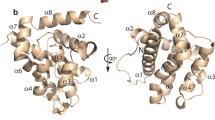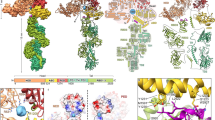Abstract
During programmed cell death (apoptosis), a protein named FLASH is required to regulate the proteolytic cascade that ends in the death of the cell. Imai and co-workers have reported1 that FLASH appears to be a functional analogue of two other apoptotic proteins, mammalian Apaf-1 and its nematode homologue CED-4, and that FLASH contains an amino-acid sequence motif that is homologous to the ATPase domain of Apaf-1, to the CED-4 sequence, and to a family of plant stress-resistant proteins that are apoptotic ATPases2. Furthermore, FLASH contains two other domains (DRD) that are apparently related to the death-effector domain (DED)1, an adaptor sequence that mediates interactions between proteins of the apoptosis machinery2. These findings should help to explain the mechanism of action of this important protein. However, we have been unable to confirm the exist-ence of these domains after re-examining the FLASH sequence.
Similar content being viewed by others
Main
We could identify no sequence similarity between FLASH and the Apaf-1/CED-4 or DED domains by searching the non-redundant protein sequence database at the NCBI using the gapped BLAST or PSI-BLAST programs3,4, and over 1,000 sequences in the database were found to be more similar to the ‘CED-4 homology’1 and ‘DED homology’ regions of FLASH than were CED-4 or Apaf-1.
Searching databases, however, may only detect less than half of all similarities between sequences in proteins that are considered to be homologues on the basis of structural comparisons5,6. Further analysis is needed, for example by direct comparison of functionally analogous proteins. We compared FLASH with Apaf-1/CED-4 and with DED-containing proteins by using the MACAW program7, but failed to detect any blocks of statistically significant sequence similarity (data not shown). We also used the PHI-BLAST program to assess the importance of the ATP-binding (P-loop) signature in FLASH (this program screens for similarity only those sequences that contain the specified signature), but found no similarity to the apoptotic ATPases even in this reduced search space. The other four motifs typical of the apoptotic ATPases2 are not conserved in the published alignment of FLASH with these ATPases.
To confirm the presence of DED-related domains in the FLASH sequence, we searched it with the DED profile by using the SMART system8 and an independent method based on the PSI-BLAST program that detects all known DED domains9, but we were unable to find any similarity to DED.
These tests cannot rule out a subtle similarity, although we believe that structure predictions for FLASH and phylogenetic analysis may effectively do so, at least with regard to the purported ATPase domain. Compositional complexity analysis using the SEG program10 indicates that FLASH is largely a non-globular protein (Fig. 1). The entire ‘CED-4 homology’ region of FLASH is predicted to be non-globular, which is incompatible with the compact structure based on a parallel β-sheet with inserted α-helices that is typical of ATPase domains11. The P-loop in ATPases and GTPases is preceded by a hydrophobic β-strand, but this feature is lacking in FLASH.
The numbered bar indicates amino-acid residue positions. Boxes, predicted globular regions; lines, predicted non-globular domains; CC, coiled-coil. Regions of alleged similarity1 to the apoptotic ATPases (CED-4) and DED domains (DRD, or DED-related domains) are indicated by broken lines. Predicted non-globular domains were detected by using the SEG program10, with the following parameters optimized for partitioning protein sequences into globular and non-globular domains: window length, 45; trigger complexity, 3.4; extension complexity, 3.7. Coiled-coil domains were predicted using the COILS2 program12; boundaries of the strongly predicted coiled-coil domain are indicated.
The argument against structural similarity is supported by phylogenetic evidence. We have cloned and partly sequenced a human homologue of FLASH which has 67% amino-acid identity with FLASH in an alignment of 1,250 residues; the P-loop signature, however, is not conserved (data not shown; GenBank accession no. AF165161).
The structural and evolutionary evidence thus indicates that FLASH contains no globular domains with predictable functions and is not homologous to its functional analogues. FLASH does contain a predicted coiled-coil domain (Fig. 1) which may mediate functionally important protein–protein interactions12 and so is probably the best available lead we have from the sequence for further experiments.
References
Imai, Y. et al. Nature 398, 777–785 (1999).
Aravind, L., Dixit, V. M. & Koonin, E. V. Trends Biochem. Sci. 24, 47–53 (1999).
Altschul, S. F. et al. Nucleic Acids Res. 25, 3389–3402 (1997).
Aravind, L. & Koonin, E. V. J. Mol. Biol. 287, 1023–1040 (1999).
Park, J. et al. J. Mol. Biol. 284, 1201–1210 (1998).
Brenner, S. E., Chothia, C. & Hubbard, T. J. Proc. Natl Acad. Sci. USA 95 6073–6078 (1998).
Schuler, G. D., Altschul, S. F. & Lipman, D. J. Proteins 9, 180–190 (1991).
Schultz, J., Milpetz, F., Bork, P. & Ponting, C. P. Proc. Natl Acad. Sci. USA 95 5857–5864 (1998).
Chervitz, S. A. et al. Science 282 2022–2028 (1998).
Wootton, J. C. & Federhen, S. Methods Enzymol. 266, 554–571 (1996).
Hubbard, T. J. P., Murzin, A. G., Brenner, S. E. & Chothia, C. Nucleic Acids Res. 25, 236–239 (1997).
Lupas, A., Van Dyke, M. & Stock, J. Science 252, 1162–1164 (1991).
Author information
Authors and Affiliations
Corresponding author
Rights and permissions
About this article
Cite this article
Koonin, E., Aravind, L., Hofmann, K. et al. Searching for FLASH domains. Nature 401, 662 (1999). https://doi.org/10.1038/44317
Issue Date:
DOI: https://doi.org/10.1038/44317
This article is cited by
-
Systems-wide RNAi analysis of CASP8AP2/FLASH shows transcriptional deregulation of the replication-dependent histone genes and extensive effects on the transcriptome of colorectal cancer cells
Molecular Cancer (2012)
-
FLASH links the CD95 signaling pathway to the cell nucleus and nuclear bodies
The EMBO Journal (2007)
-
The CD95(APO-1/Fas) DISC and beyond
Cell Death & Differentiation (2003)
-
The death effector domain protein family
Oncogene (2003)
-
Quod erat demonstrandum?The mystery of experimental validation of apparently erroneous computational analyses of protein sequences
Genome Biology (2001)
Comments
By submitting a comment you agree to abide by our Terms and Community Guidelines. If you find something abusive or that does not comply with our terms or guidelines please flag it as inappropriate.




